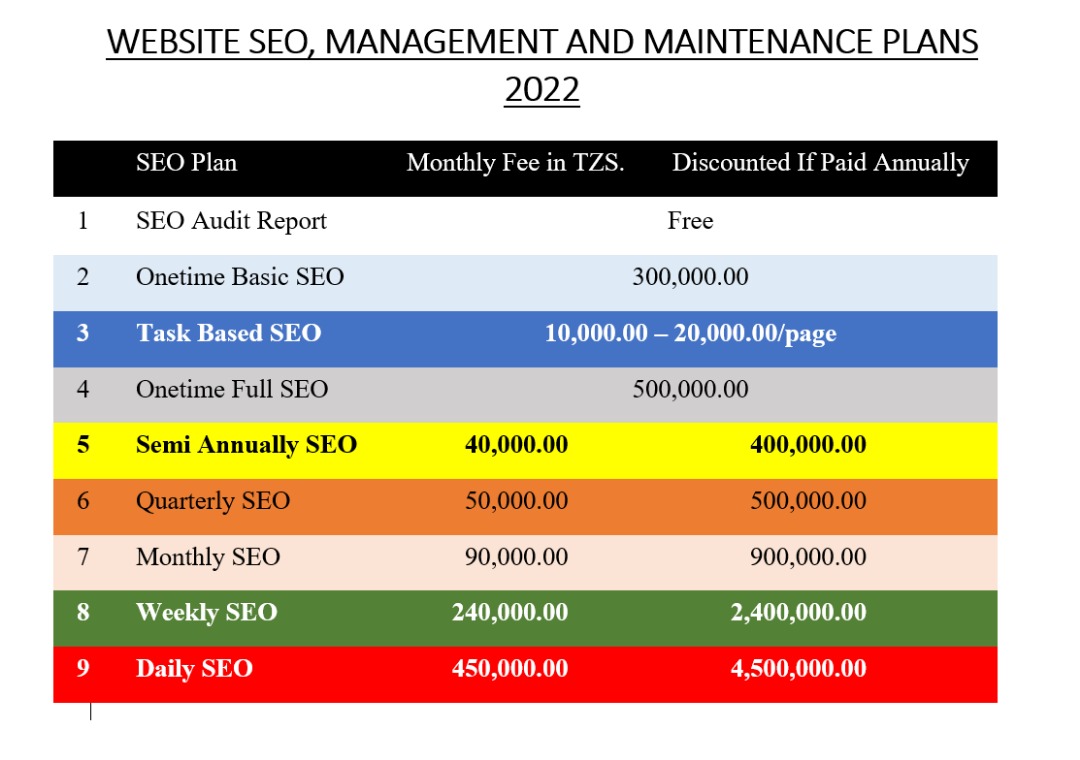
How to Write a SEO Optimized Blog Post
What is a blog?
A blog, short for weblog, is a frequently updated web page used for personal commentary or business media content. Blogs webpages normally contain posts/articles which are often interactive and include sections at the bottom where readers can leave comments or ask questions to make it interactive.
A blog is suitable for online personal news sharing where readers engagement is a paramount
What is blog content?
The blog content is post or article that are written on a blog. It can include content in the form of text, photos, infographics, or videos. Make sure you always have an engaging introduction, quality content, and a solid conclusion
Pre-Blog Post Writing
Before starting to write a post please consider the following:
- Research your competitors by reading their posts to see what are they delivering to their audience for purpose of learning only. By doing so you will improve a lot your post writing skills
- Make sure you have all the tools needed to write a post
- Get refreshment, entertainment, comfort,
- Improve your posts topic of preference from analytics. Analytics will show you the most read post and thus you will learn the most preferred topic. Build from their and write as many posts for that topic to boost you visits
- Write Guest Post. Request to write posts for other websites to increase traffic to your website
- Write posts on trending events related to your industry. Example if a great legendary leader or celebrity is visiting your location immediately write a post on that visit by integrating with your industry.
- Allow others to write posts to your blog. Influence your friends and visitors who have hobbies of writing the blog to post something to your blog
- Reference URL for 10 Steps to Become a Paid Online Article Writer
What are components of a good written blog post?
These are components of a blog post
- Highly Attention-Grabbing Headline
- A Compelling Short Description or Summary
- Useful Sub-Headings
- Adequate and Quality Engaging Description (Main body of your article)
- Appealing Graphics and Images
- Relevant Internal and Outbound Links
- Powerful Call-To-Action (CTA)
- Good Meta Description
- Audience Aware Content
- Get Others’ Opinions
- Publicize Your Post to External Outlets
- Inspiring Author biography with contacts
1) Highly Attention-Grabbing Headline
Assume that you don’t have any other space to explain about your story and that you have only less than 60 characters including spaces to tell us your story and still being understood?
Your blog headline must contain the following:
- Give summary of what your article is all about.
- Inspire the reader to at least read the short description of your blog post.
In other words, it needs to be magnetic—it needs to pull people in.
Sometimes adding emotional words to the headline will give it the added magnetism required. In other cases, the information you’re offering will, on its own, be enough of a draw. However, even when you’re presenting great content, spice up your headline with a word or two that will grab readers and make it stand out. People are moved to act by their emotions.
2) A Compelling Short Description or Summary
Just like the blog headline you don’t have much space to explain everything about your story and that you have only less than 160 characters including spaces to tell us your story and still being understood?
Your blog short description must contain the following:
- Give summary of what your article is all about.
- Inspire the reader to read the full description of your blog.
What is the word “compelling” mean in regard to this topic?
Compelling involve raising emotions, feeling, admiration, irresistibility about something ahead of the person. The first sentence or short paragraph of your blog must compel visitors to read your second paragraph—you want to draw your readers in. Don’t take forever to get to the point, and make sure there’s sufficient build up so that readers will want to know more about the information you’re presenting and appreciate it once they understand your ideas.
3) Useful Sub-Headings
The quality of sub-headings must follow the same principle of Heading above
The sub-heading must be described in no more than 55 characters with spaces the underlying paragraphs
Subheads serve three purposes:
- They break up the story to make it more visually appealing
- They help your reader navigate to important sections of preference.
- They increase points to specific keywords and hence boost search engine optimization (SEO).
A long page of continuous type turns away a lot of potential readers. We’ll come back to this in the section on graphics. Also, once readers finish your article, they may want to jump back and go over a point; subheads should help this.
Each sub heading must mention at least a word that is included in the primary page keyword.
4) Adequate and Quality Engaging Description
If the article or post of your blog is an EGG, then the body is the “YOLK” of your blog post. These aspects needed to be observed while writing your post body:
- Simple language, never insert difficult or bombastic words
- Organize your point in a logical manner
- Correct grammar and spelling (best tool https://www.grammarly.com/ )
- Don’t use only paragraphs throughout, sometimes use bullets to pinpoint important points
- Use images or photos or video to illustrate important points
- Always use links for reader further reference
- Use sub-sub headings if needed and followed the correct hierarchy principle
- Always have a second opinion about your writing
5) Appealing Graphics and Images
It’s a great idea to include graphics in your blog posts to illustrate points and break up text within the body of articles to make your pages more visually pleasing. Google measures the time spent on your pages, so your graphics, typography, and color scheme should work together to encourage visitors to stick around. Also, when you promote your content on social media, you should include a visually interesting graphic.
6) Relevant Internal and Outbound Links
You should include relevant links to other articles on your site in every new article you write so that visitors will benefit while browsing your pages by getting all the information they need and for this case they spent more time in the page.
Internal links benefit your SEO because they increase the number of pages per visit, number of clicks and time visitors are on your site.
Outbound relevant links to authoritative sites on the other end are considered in the algorithms and do have a positive impact on rankings.”
“Linking to other websites is a great way to provide value to your users. Often, links help users to find out more, to check out your sources and to better understand how your content is relevant to the questions that they have.”
— John Mueller, Google
Does the content present information in a way that makes you want to trust it, such as clear sourcing, evidence of the expertise involved, background about the author or the site that publishes it, such as through links to an author page or a site’s About page?
— Google Webmaster Blog
The main thing to take away from this test is that although we don’t know and have not proved how powerful outgoing links are in the grand scheme of things, we have proved they do have a positive impact if used correctly.
More importantly, we disproved the old myth of Pagerank retention which in my opinion has done nothing but harm to the internet as a whole as webmasters try to keep the ‘link juice’ in house slowly eroding the building blocks of the web.
— Reboot Online
By summing up, this will increase visitors trust to your web page and will attract many to make trusted reference to others and for this case will increase the number of webpage visits, number of clicks and time visitors are on your site and thus adding more to your ranking points.
7) Powerful Call-To-Action (CTA)
Almost every blog article should have some kind of call-to-action, which can take a variety of forms and be achieved through different tactics. Your first step is to decide what action you want your visitors to take. It might be to make a comment. It could be to read another blog on your site, or to check out a product or service you offer. You also could get a prospect’s contact information by offering exclusive content in exchange for an email address.
8) Good Meta Description
The meta description is the snippet Google displays in search results. Left to its own devices, Google will grab the first sentence or two from your article. This, however, may not always be the best way for your article to appear in search results.
9) Audience Aware Content
Now days you can use AI tools to convert your blog content to any international language via text or text to audio and then create some slideshow where you can post as video in YouTube etc. Example are Blaster Suite Online (blasteronline.com)
10) Get Others’ Opinions
Why is it so important to get others’ opinions?
A blog is a living thing just like other living beings. It starts young, it grows and get matured. In this course your will be monitoring this grow by improving your content every day. You can only improve your content if you have improved your blog content writing skills by visiting other blogs for personal review, and therefore, you will end up writing quality and professional posts.
There are three stages to get others’ opinions
- Visit other competitive blogs of your industry to learn how do they approach post writing and then…
- Getting the reviews from your partners, friends or closest family members who are familiar with your industry and then…
- At the end of your post ask questions or insert a simple survey form to get audience opinion. You can also and Rection buttons and or insert a multi platform social media comments button to make your post interactive and engaging.
Question or comment form should focus on what is missing in the post and that readers want to be added. You can also ask the readers what other topic they prefer to be posted parallel to the post on question.
11) Publicize Your Post to External Outlets
Make sure that you integrate your blog to auto blogging so that your post once completed are shared to other media including social media. This requires that your website contain automation tools
At the end of the post put a post sharing button to your preferred social media, print and send to email
12) Inspiring Author biography with contacts
The author biography will add many values to your article in these ways
- The inspiring message will add trust and reliability to the article by your readers
- The contacts will make it easy for your readers to ask questions or send recommendations directly to the author



